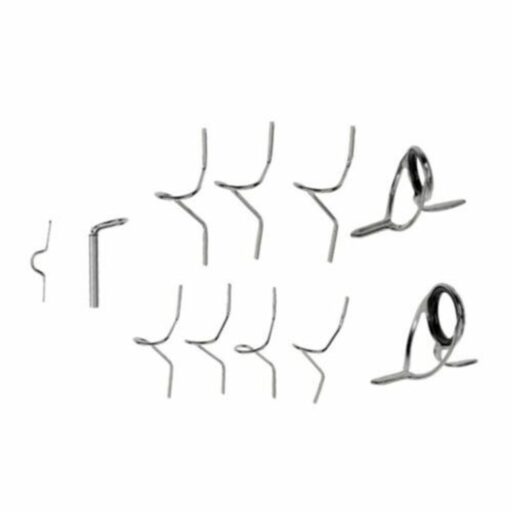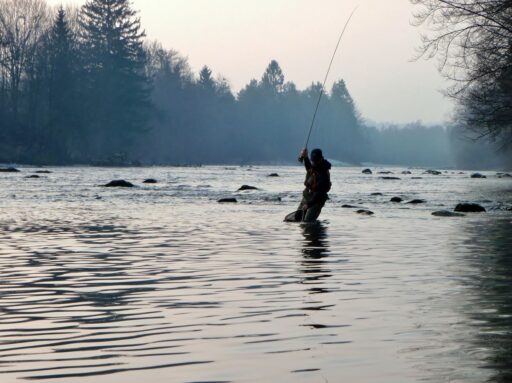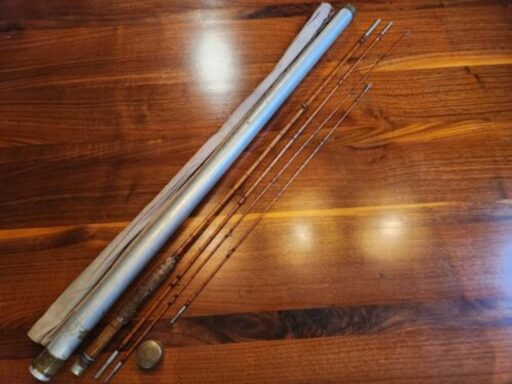Fly fishing is an art form that combines skill, patience, and the right equipment. Building your own custom fly fishing rod can elevate this experience, providing a unique connection to the sport and a sense of pride in your craftsmanship. This article delves into the process of creating a custom rod, from selecting materials to mastering advanced customization techniques, and even engaging with the broader fly fishing community.
Key Takeaways
- Custom rod building allows for a personalized fishing experience, enabling anglers to tailor their gear to specific fishing conditions and personal style.
- The selection of materials and tools is crucial in rod crafting, as they determine the rod’s functionality, durability, and overall performance.
- Advanced techniques in rod customization, such as working with decorative wraps and finishes, can enhance both the aesthetics and effectiveness of the rod.
- Beyond the rod itself, mastering casting techniques and understanding environmental dynamics are essential to fully enjoy the art of fly fishing.
- Joining the fly fishing community offers opportunities for continuous learning, sharing experiences, and contributing to conservation efforts.
The Foundations of Custom Rod Building

Choosing the Right Materials
The journey to crafting your custom fly fishing rod begins with selecting the right materials. The choice of materials will significantly influence the rod’s performance, durability, and appearance. Each component, from the rod blank to the guides, requires careful consideration to ensure they meet your fishing needs and aesthetic preferences.
- Rod Blanks: The backbone of your rod, typically made from graphite, fiberglass, or bamboo.
- Guides: Crucial for line control, available in various materials like stainless steel or ceramic.
- Handle Materials: Cork and EVA foam are popular for their comfort and grip.
- Reel Seats: Choose based on the type of reel and personal style; options include aluminum, nickel silver, or wood inserts.
When it comes to materials, balance is key. A well-chosen combination can result in a rod that not only looks stunning but also performs exceptionally on the water. Remember, the best material is the one that feels right in your hands and under your unique casting style.
Essential Tools for Rod Crafting
Building your own fly fishing rod requires a set of specialized tools to ensure precision and quality. A reliable rod wrapper is essential for securing guides and decorative wraps to the rod blank. Alongside this, a good set of files and sandpaper are necessary for shaping the handle and ensuring a smooth finish.
For the assembly process, you’ll need strong adhesives and a thread finishing epoxy to bond components and protect thread wraps. A pair of sharp scissors and a thread burner are also indispensable for cutting and sealing thread ends.
Here’s a list of the basic tools you’ll need to get started:
- Rod wrapper
- Files and sandpaper
- Strong adhesives (e.g., two-part epoxy)
- Thread finishing epoxy
- Scissors
- Thread burner
Remember, the quality of your tools can greatly influence the final outcome of your rod. Investing in higher-quality tools can make the crafting process more enjoyable and yield a better-finished product.
Understanding Rod Blanks and Guides
When building a custom fly fishing rod, the selection of rod blanks and guides is crucial for achieving the desired performance. Rod blanks are the backbone of your rod, dictating its flexibility, strength, and sensitivity. They come in various materials such as graphite, fiberglass, or bamboo, each offering distinct advantages. Guides, on the other hand, are the rings along the rod through which the fishing line is threaded. Their placement and spacing are vital for the rod’s casting ability and sensitivity.
Choosing the right combination of rod blanks and guides can be daunting, but it’s a process that rewards patience and precision. Here’s a simple list to help you get started:
- Determine the type of fishing you’ll be doing and the species you’re targeting.
- Consider the action and power you need from the rod.
- Select a material that suits your fishing style and conditions.
- Space the guides evenly to ensure smooth line flow.
Remember, the goal is to create a rod that feels like an extension of your arm, one that responds intuitively to your movements and the environment.
Once you’ve selected your materials and designed your layout, the next step is to carefully align and secure the guides. This will ensure that your custom rod performs at its best, whether you’re casting on a serene lake or battling a feisty trout in a rushing stream. With the right knowledge and tools, you can craft a rod that’s perfectly tailored to your fishing adventures.
Designing Your Custom Fly Fishing Rod

Incorporating Personal Style and Functionality
When building your custom fly fishing rod, personal style and functionality are paramount. This is your chance to create a rod that not only looks great but also performs to your unique fishing preferences. Consider the following points:
- Ergonomics: The rod should feel comfortable in your hand, with a grip tailored to your hold.
- Aesthetics: Choose colors and patterns that reflect your personal taste.
- Functionality: Ensure the rod components work well together and suit the type of fishing you’ll be doing.
Remember, the goal is to blend your personal style with practical functionality to create a rod that is both a joy to use and a reflection of your personality.
Many websites offer guides on making fishing rods at home, detailing the use of materials like bamboo or PVC. These resources can provide valuable tips on components and customization for different fishing styles. However, always weigh the pros and cons of each material and consider the FAQs to avoid common pitfalls.
Selecting the Perfect Reel Seat and Handle
The reel seat and handle are the points of contact between the angler and the rod, making their selection crucial for comfort and control. Choosing the right combination can greatly enhance your fishing experience. The reel seat must secure the reel firmly, preventing any play that could interfere with sensitivity and accuracy. Handles, typically made from cork or EVA foam, should fit comfortably in your hand for hours of fatigue-free fishing.
When selecting a reel seat, consider the type of fishing you’ll be doing. For example, saltwater fishing may require corrosion-resistant materials, while freshwater fishing allows for a wider range of options. The handle shape is also important; some anglers prefer a full grip for stability, while others opt for a split grip for a lighter rod and increased sensitivity.
The perfect reel seat and handle combination should feel like an extension of your arm, providing a seamless connection to the rod and the water below.
Here’s a quick checklist to guide you through the selection process:
- Ensure the reel seat locks the reel in place without wobbling.
- Choose a handle material that offers both comfort and durability.
- Consider the handle length and shape based on your casting style and preference.
- Look for quality craftsmanship to ensure longevity and performance.
Balancing Aesthetics with Performance
When building your custom fly fishing rod, it’s crucial to strike a balance between the visual appeal and the rod’s functionality. A rod that looks stunning but performs poorly will not enhance your fishing experience. Conversely, a high-performing rod with lackluster aesthetics may not provide the personal satisfaction that comes with creating something uniquely yours.
To achieve this balance, consider the following points:
- The weight and flexibility of the rod should match the type of fishing you intend to do.
- The choice of materials can affect both the rod’s appearance and its action on the water.
- Decorative elements should not interfere with the rod’s structural integrity or its performance.
Remember, the ultimate goal is to create a rod that feels like an extension of yourself when you’re out on the water, one that not only catches fish but also turns heads.
Finally, don’t be afraid to experiment. Custom rod building is as much an art as it is a science, and sometimes the most innovative designs come from a willingness to try new things and learn from the results.
Advanced Techniques in Rod Customization
Working with Decorative Wraps and Finishes
Decorative wraps and finishes are the final touches that make your custom fly fishing rod truly unique. Choosing the right pattern and color scheme can transform the rod from a simple tool to a work of art. The process requires patience and precision, but the results are well worth the effort.
- Start by selecting the thread for your wraps. Consider the overall color palette of your rod and how the thread will complement it.
- Carefully plan the design of your wraps. Symmetry and spacing are key to achieving a professional look.
- Apply the finish evenly, ensuring that it penetrates the thread wraps fully for a durable and glossy appearance.
When applying the finish, it’s crucial to maintain a dust-free environment to avoid imperfections. A smooth, even coat will enhance the rod’s aesthetic and protect the thread wraps for years of use.
Remember, the devil is in the details. Taking the time to meticulously apply your decorative wraps and finishes will set your custom rod apart and reflect your personal style on the water.
Customizing for Specific Fishing Conditions
Customizing your fly fishing rod for specific conditions is not just about aesthetics; it’s about maximizing your efficiency and success rate on the water. Understanding the environment and target species is crucial to selecting the right rod components and modifications. For instance, deep-sea fishing requires gear that can withstand the immense pressures and challenges of the ocean depths.
- For deep-sea challenges, specialized gear such as electric reel systems, heavy-duty rods, and braided lines are essential.
- In freshwater streams, lighter rods and specific fly patterns may be more effective for the local fish species.
- Saltwater flats fishing might call for rods with greater casting distance and corrosion-resistant materials.
By tailoring your rod to the fishing conditions, you not only enhance your experience but also increase your chances of a successful catch. Customization allows anglers to adapt to the ever-changing scenarios they face, ensuring that their gear is as dynamic as the environments they fish in.
Innovations in Rod Technology and Materials
The fly fishing industry is constantly evolving, with new technologies and materials emerging to enhance the angling experience. Electric reel systems have become a game-changer, especially for deep-sea challenges, allowing anglers to tackle the depths with greater efficiency and less physical strain. These systems, which can be activated with the touch of a button, are revolutionizing deep drop fishing.
In the competitive arena, events like the Bass Pro Shops REDCREST 2024 showcase the latest advancements in rod technology. Anglers are now equipped with gear that can withstand the rigors of professional tournaments, reflecting the industry’s commitment to innovation.
The integration of new materials and technology in rod building not only improves functionality but also opens up possibilities for customization, catering to the specific needs of anglers.
Here are some recent innovations in rod technology and materials:
- High-modulus graphite for increased sensitivity and strength.
- Nano-resin composites for lighter, more durable rods.
- Adjustable reel seats for a personalized grip and balance.
- Thermal plastic grips that conform to the angler’s hand for better control.
These advancements are not just about performance; they also allow for a higher degree of personalization, ensuring that each rod can be as unique as the angler wielding it.
The Art of Fly Fishing: Beyond the Rod

Mastering Casting Techniques
Mastering the art of casting is essential for any fly fishing enthusiast. Proper casting ensures your fly lands precisely where you want it, increasing your chances of a successful catch. It’s a skill that requires patience and practice, but with the right techniques, you can become proficient.
- Start with the basic overhead cast to get a feel for the rod’s action.
- Progress to more advanced casts like the roll cast and the double haul for different fishing scenarios.
- Pay attention to your timing and the rhythm of your casts; these are crucial for accuracy and distance.
Remember, each cast is an opportunity to connect with the water and the fish. It’s not just about technique; it’s about the experience and the environment you’re in.
Continual practice is key, and seeking advice from seasoned anglers can accelerate your learning curve. Visit our website page for a variety of fishing rods and tips for different types of fishing, including posts on choosing the best rods for bass, trout, and more.
Fly Selection and Tying Your Own Flies
Selecting the right fly is a critical aspect of fly fishing, as it can greatly influence your success on the water. Understanding the local insect life and matching your fly accordingly is a fundamental skill for any angler. Here’s a simple guide to get you started:
- Observe the insects and fish behavior in your fishing area.
- Match the size, color, and pattern of your fly to the local insects.
- Consider the water conditions and choose the appropriate fly weight.
Tying your own flies adds a personal touch to your fishing experience and can be incredibly rewarding. It allows for customization and adaptation to specific fishing conditions. Start with a basic set of tools: vise, scissors, thread, and hooks, and explore the variety of materials available to create your own unique patterns.
By mastering the art of fly selection and tying, you not only enhance your fishing experience but also deepen your connection with the natural environment.
Understanding River and Stream Dynamics
To truly excel in fly fishing, one must become attuned to the rhythms and patterns of rivers and streams. These dynamic ecosystems are influenced by a variety of factors that affect water flow and fish behavior. Understanding these elements can greatly enhance your fishing strategy and success.
- Water Temperature: Influences fish metabolism and feeding patterns.
- Flow Rate: Dictates the positioning of fish and their accessibility.
- Substrate Composition: Affects the availability of aquatic insects, a primary food source.
- Vegetation: Provides cover for fish and habitat for their prey.
By closely observing and adapting to the changing conditions of a river or stream, anglers can anticipate where fish are likely to be and what type of flies they might be receptive to.
It’s also important to consider the impact of human activities on these waterways. Pollution, water extraction, and habitat destruction can all alter the productivity of a trout stream. The concept of ‘Unlocking the Mysteries of Trout Stream Productivity‘ involves exploring nutrients, calcium, and stream variability to understand and mitigate these impacts.
Joining the Fly Fishing Community

Participating in Events and Competitions
Entering the world of fly fishing competitions can be a thrilling way to test your skills and meet like-minded enthusiasts. Competitions range from local to international levels, offering a variety of experiences for anglers of all proficiencies. To get started, familiarize yourself with the event schedules and the types of competitions available.
- The Fly Fishing Show is a notable event that brings together the community and showcases the latest in fly fishing gear and techniques.
- Major League Fishing (MLF) offers a spectrum of circuits, such as the Bass Pro Tour and REDCREST 2024, catering to different skill levels and interests.
- For those looking to contribute to conservation efforts, MLF’s Fisheries Management Division holds events that combine competition with environmental stewardship.
By participating in these events, you not only sharpen your angling skills but also contribute to the sport’s growth and sustainability. It’s a chance to learn from seasoned pros and to share your passion for fly fishing with a wider audience.
Connecting with Other Anglers Online and Offline
In the digital age, connecting with fellow anglers has never been easier. Online forums and social media groups are bustling hubs where you can share experiences, seek advice, and showcase your custom rod creations. Websites like ‘Best Fishing Rods Team‘ offer a wealth of information, featuring a variety of fishing rods for different types of fishing, with guides and reviews to help you make informed decisions.
Offline, local fishing clubs and meet-ups provide invaluable opportunities to network and learn from seasoned fishers. Participating in these groups can lead to friendships, mentorships, and even partnerships in rod building ventures. It’s a chance to immerse yourself in the culture and traditions of fly fishing, gaining insights that go beyond the digital realm.
Embrace the camaraderie of the angling community by engaging both online and in person. The shared passion for fly fishing creates a unique bond that can enrich your experience and knowledge in the sport.
Contributing to Conservation and Ethical Fishing Practices
Contributing to conservation and ethical fishing practices is a cornerstone of the fly fishing community. By adopting sustainable habits, anglers can ensure the longevity of fish populations and the environments they inhabit. This not only benefits the ecosystem but also enriches the fishing experience for future generations.
- Practice catch and release where appropriate to maintain fish populations.
- Use barbless hooks to minimize injury to fish.
- Support local conservation efforts and participate in habitat restoration projects.
- Stay informed about the health of local fisheries and advocate for responsible management practices.
As a member of the fly fishing community, it’s our responsibility to act as stewards of the waterways we cherish. By engaging in conservation and ethical practices, we uphold the sport’s integrity and contribute to its sustainable future.
Joining forces with organizations that promote sustainable fishing can amplify your impact. The National Geographic Society, for example, provides valuable insights into how indigenous cultures have historically maintained balance with nature. By learning from these practices, modern anglers can adopt strategies that support both the sport and the environment.
Conclusion
In the journey of crafting your own custom fly fishing rods, you’ve not only embraced a hobby that enhances your fishing experience but also tapped into a wellspring of creativity and personal expression. The process of selecting materials, understanding the nuances of rod dynamics, and tailoring your equipment to suit your fishing style is both an art and a science. As you refine your craftsmanship, you’ll find that each rod you create is more than just a tool—it’s a testament to your passion for the sport and a companion on countless adventures. Whether you’re wading through a serene stream or embarking on deep-sea challenges, your custom rod will be a unique extension of your angling prowess, bringing you closer to the natural world and the thrill of the catch. So, gather your materials, harness your creativity, and let the building of your custom fly fishing rod begin a new chapter in your fishing legacy.
Frequently Asked Questions
What materials do I need to start building my custom fly fishing rod?
To start building your custom fly fishing rod, you’ll need a rod blank, guides, a reel seat, a handle (usually made of cork or foam), thread for wrapping guides, epoxy, and a finishing coat. Additional tools and decorative elements may be required based on your design preferences.
How do I choose the right rod blank for my custom fly fishing rod?
Choosing the right rod blank depends on the type of fishing you plan to do. Consider the length, power, and action of the rod, which should align with the species of fish you’re targeting and the fishing conditions. Test different blanks if possible to find the one that feels right for you.
Can I incorporate my own style into my custom rod?
Absolutely! Custom rod building is an opportunity to express your personal style. You can choose colors, patterns, and even incorporate unique materials into your handle and wraps. The design choices are vast, allowing you to create a rod that is both personal and functional.
What are some advanced techniques I can use to customize my rod?
Advanced customization techniques include working with decorative wraps, experimenting with different finishing coats, and applying intricate thread art. You can also tailor your rod to specific fishing conditions by selecting specialized guides and materials that enhance performance in those environments.
How can I improve my fly fishing technique beyond custom rod building?
Improving your fly fishing technique involves mastering casting methods, understanding river and stream dynamics, and learning to tie your own flies to mimic local insect life. Practice regularly, and consider taking workshops or guided trips with experienced anglers to enhance your skills.
How can I connect with the fly fishing community and contribute to conservation?
You can connect with the fly fishing community by participating in local events and competitions, joining online forums, and engaging with social media groups. Contributing to conservation can involve practicing catch-and-release, participating in habitat restoration projects, and advocating for sustainable fishing practices.





